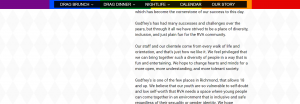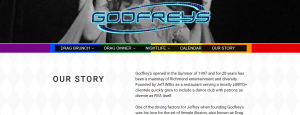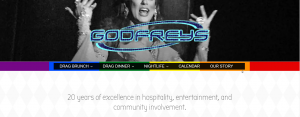
http://godfreysva.com/our-story/
Godfrey’s website exhibits some of the constraints common to risk rhetoric. In their case, the most prominent constraint is the emotionally laden nature of risk topics. Topics like the persistent marginalization of the LGBTQ+ community and its detrimental side effects (to individuals like Matthew Shephard and to larger groups such as the victims of the Pulse shooting) are often difficult to discuss because of their grim nature. Additionally, Godfrey’s wishes to depict itself primarily as a business that offers customers a good time rather than a monument to the atrocities committed against the LGBTQ+ community. This mindset likely played a role in their vague crafting of information on their website (see above photo).
Non-experts serve as the primary audience in this case. The rhetoric on Godfrey’s website appeals to both seasoned drag enthusiasts as well as newcomers to this form of entertainment. Godfrey’s explanation of their history and the history of female illusion in Richmond leaves room for improvement; however, this section provides enough information that non-experts feel acquainted enough with the nature of Godfrey’s to make an informed decision about whether or not to visit the club.
With respect to risk, Godfrey’s makes some effort to enhance their organizational credibility. They describe themselves as existing “long before mainstream media acceptance [of drag] and before the days of reality television like Ru Paul’s Drag Race.” This statement implies that they are not simply participating in a fad or appeasing an audience which, in the contemporary moment, approves of drag or enjoys it as a spectacle. Instead, Godfrey’s asserts that their organization provided a safe space for this art form even before doing so was socially acceptable. By extension, they suggest that their experience in tension-ridden times for the LGBTQ+/drag communities make them qualified to defend patrons as individuals and groups. Additionally, Godfrey’s notes that they strive to be “a space where young people can come together in an environment that is inclusive and safe regardless of their sexuality or gender identity.” Here, the organization contends that they attempt to create a safe space where atrocities against the LGBTQ+ community will (ideally) not occur.
Godfrey’s rhetoric limits participation in the risk assessment process. On their “About Us” page, they include no detailed descriptions of past risks or struggles, simply stating that “Godfrey’s has faced…many challenges over the years.” The crafting of this statement limits audience participation in risk assessment because it does not give audiences a chance to collect specific information about the history of Godfrey’s, risks they previously faced, and risks they may face in the future. By excluding any positive or negative history, the organization does not present information in ways that allow audiences to make fully informed decisions about risks.


